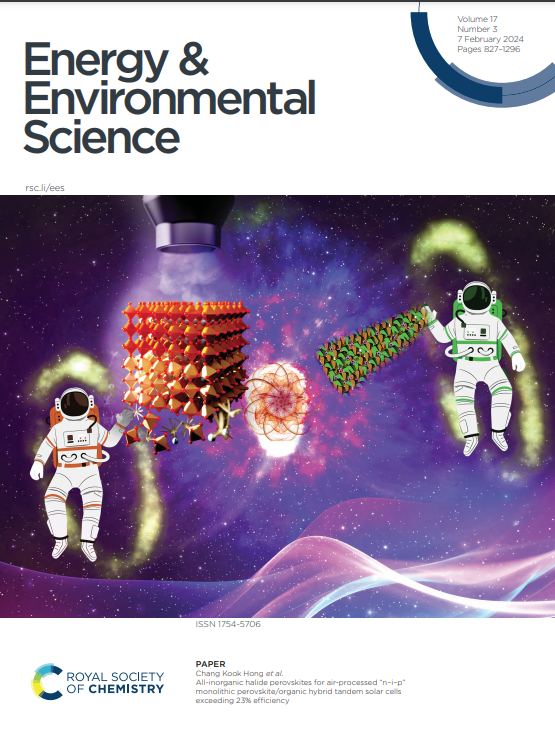利用可扩展且本质安全的光催化Z-scheme电化学滚道系统实现水电解太阳能制氢的成本和碳强度平衡
IF 32.4
1区 材料科学
Q1 CHEMISTRY, MULTIDISCIPLINARY
引用次数: 0
摘要
利用可再生资源生产氢气将开启一种低碳能源载体,可用于减少工业和交通运输等部门的温室气体排放。然而,由于有关排放核算的争议,将新的或现有的可再生能源发电分配给氢气生产仍然存在争议。光催化(PC)制氢技术提供了一种独特的解决方案,因为氢直接从太阳能和水中产生,而不需要发电。然而,迄今为止所有光催化设计的成本预测表明,与大规模生产的传统电解系统相比,它们在成本上并不具有竞争力。在此,我们提供了第一个说明性的基准,在2型“z方案”光催化反应器设计中产生氢的成本和碳强度,该设计采用悬浮的半导体纳米导体颗粒,在滚道设计中组织成两个堆叠的体积。“z方案”系统利用两个独立的光吸收粒子,分别驱动析氢反应或析氧反应,通过溶液中的可逆电荷转移氧化还原偶联连接。结果表明,这是一种极具竞争力和可扩展的技术,证明了该领域进一步的实验验证和原型设计是合理的。本文章由计算机程序翻译,如有差异,请以英文原文为准。
Levelized cost and carbon intensity of solar hydrogen production from water electrolysis using a scalable and intrinsically safe photocatalytic Z-scheme electrochemical raceway system
Generating hydrogen from renewable resources would unlock a low-carbon energy carrier that could be used to reduce greenhouse gas emissions in sectors such as industry and transportation. Yet, the allocation of new or existing renewable electricity generation solely to hydrogen production remains contentious due to disputes regarding emissions accounting. Photocatalytic (PC) hydrogen production technologies offer a unique solution, as hydrogen is produced directly from solar energy and water, without the need for electricity generation. However, cost projections for all photocatalytic designs to date have suggested that they are not cost competitive compared to conventional electrolysis systems manufactured at scale. Herein, we offer the first illustrative benchmark of cost and carbon intensity of hydrogen produced in a Type 2 “Z-scheme” photocatalytic reactor design, which employs suspended semiconducting nanoconductor particles organized into two stacked volumes in a raceway design. The “Z-scheme” system utilizes two separate photoabsorber particles, tuned to drive either the hydrogen evolution reaction or the oxygen evolution reaction individually, connected via a reversible, charge transfer redox couple in solution. The results suggest a highly competitive and scalable technology, that justifies further experimental validation and prototyping in the field.
求助全文
通过发布文献求助,成功后即可免费获取论文全文。
去求助
来源期刊

Energy & Environmental Science
化学-工程:化工
CiteScore
50.50
自引率
2.20%
发文量
349
审稿时长
2.2 months
期刊介绍:
Energy & Environmental Science, a peer-reviewed scientific journal, publishes original research and review articles covering interdisciplinary topics in the (bio)chemical and (bio)physical sciences, as well as chemical engineering disciplines. Published monthly by the Royal Society of Chemistry (RSC), a not-for-profit publisher, Energy & Environmental Science is recognized as a leading journal. It boasts an impressive impact factor of 8.500 as of 2009, ranking 8th among 140 journals in the category "Chemistry, Multidisciplinary," second among 71 journals in "Energy & Fuels," second among 128 journals in "Engineering, Chemical," and first among 181 scientific journals in "Environmental Sciences."
Energy & Environmental Science publishes various types of articles, including Research Papers (original scientific work), Review Articles, Perspectives, and Minireviews (feature review-type articles of broad interest), Communications (original scientific work of an urgent nature), Opinions (personal, often speculative viewpoints or hypotheses on current topics), and Analysis Articles (in-depth examination of energy-related issues).
 求助内容:
求助内容: 应助结果提醒方式:
应助结果提醒方式:


